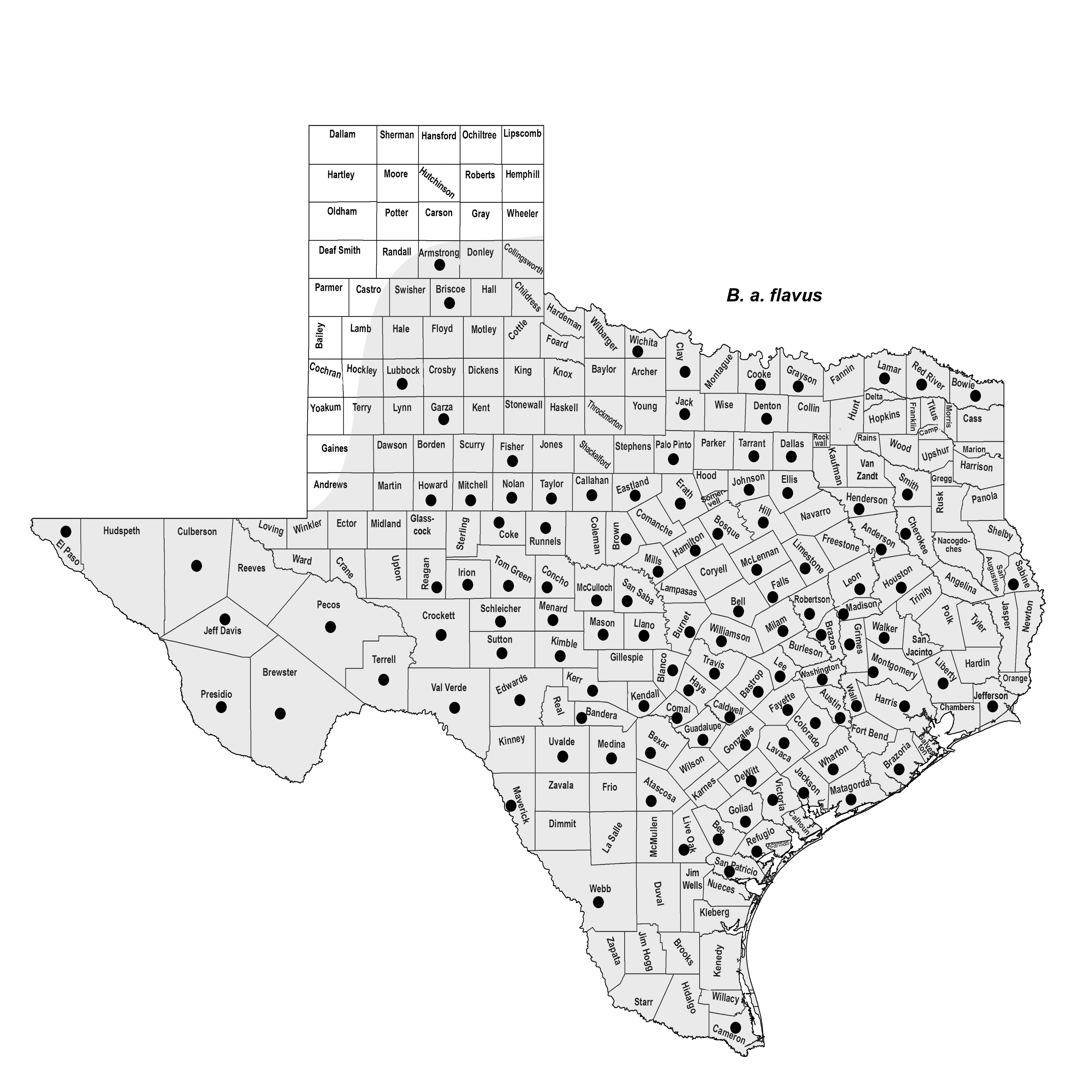RINGTAIL
Bassariscus astutus (Lichtenstein 1830)
Order Carnivora : Family Procyonidae
DESCRIPTION. A cat-sized carnivore with a long raccoon-like tail; tail flattened, about as long as head and body, banded with 14–16 alternating black and white rings (black rings incomplete on underside), and with a black tip; five toes on each foot, armed with sharp, curved, nonretractile claws; upperparts fulvous, heavily overcast with blackish; face sooty gray with large, distinct, whitish area above and below each eye, and one at anterior base of each ear; eye ring black; back of ears whitish toward tip, grayish basally; underparts whitish, tinged with buff; underfur all over plumbeous. Dental formula: I 3/3, C 1/1, Pm 4/4, M 2/2 × 2 = 40. Averages for external measurements: of males, total length, 802 mm; tail, 410 mm; hind foot, 78 mm; of females, 714-350-65 mm. Weight, 1–1.5 kg.

DISTRIBUTION. Statewide except Panhandle and Rolling and High Plains areas. Ringtails are common in the Trans-Pecos, Edwards Plateau, and Cross Timbers regions of western and central Texas. They are less common in the woodland areas of eastern Texas. In the Edwards Plateau and Trans-Pecos regions, ringtails occur in the rocky, brushy country. To the east, they live in wooded areas, usually close to water, and they den in hollow trees and logs.

SUBSPECIES. Bassariscus a. flavus.
HABITS. Ringtails are strictly nocturnal and are active mainly during the middle of the night. They are nimble climbers and are extremely quick. Their hind feet are clawed and resemble those of a domestic cat, leading to the moniker "ringtailed cat." Their hind feet can be rotated externally at least 180 degrees, permitting them to run rapidly down a tree trunk or steep rock headfirst instead of having to back down the way a domestic cat does.
Ringtails normally den alone, although members of a family group (a female and her kittens) may den close together. Favored den situations include rock caves, hollow trees and logs, and brush piles. Females seem to prefer rock dens, whereas males tend to select dens in hollow trees and brush piles. Ringtails have rather sizeable home ranges, with females averaging about 20 ha (49 acres) and males about 43 ha (106 acres). Home ranges of females are not overlapping, although they are overlapped by those of one or more males for breeding purposes. Home ranges of males do not overlap.
Breeding occurs from mid-March to mid-April. Females are monestrous and often emit a series of loud chirping calls that may serve as a signal to the male that the female is ready to copulate. Gestation lasts 51–54 days.
Young (kits) are born from mid-May to mid-June and usually number two to four. Kits are altricial with closed eyes, no teeth, and fuzzy hair. The eyes open 31–34 days after birth, by which time the young are fully furred. The kits eat meat when 7 weeks old and are weaned in August at about 8 weeks of age, at which time they begin to forage with their parents. They begin to den independently about the end of September but associate with their mother until at least the onset of winter. They exhibit the first signs of sexual activity when only 13 weeks of age, and by 19 weeks they are of adult appearance and behavior. Occasionally young of the year mate, but typically mating occurs at the end of the second year.
Ringtails eat a wide range of both plant and animal food. Small mammals form the largest part of the diet (62% of the volume) and fruits represent 28%. Small birds are third in importance (7%), with the remainder consisting of, in descending order of importance, insects, invertebrates other than insects, and cold-blooded vertebrates.
Ringtails are quite vocal and emit several calls. The barking sound is made by both sexes whenever they become frightened or agitated; the sound may intensify to a growl or scream when a ringtail is further frightened. When females come into estrous, they emit a series of loud chirping calls that may serve as a signal to the male that the female is ready to copulate.
Known predators include great-horned owls, coyotes, and humans. Ringtails have ranked approximately seventh among the most important fur-bearing animal on the Edwards Plateau, but their importance is considerably less in other regions of the state.
POPULATION STATUS. Common. Ringtails are common throughout the rocky habitats of the western and central parts of the state. They are less abundant in eastern and southern Texas and the plains area of the Panhandle. Although ringtails are seldom seen due to their secretive habits, trapping and camera trap data often document that they are more common than realized.
CONSERVATION STATUS. The IUCN lists the ringtail as a species of least concern, and it does not appear on the federal or state lists of concerned species. There do not appear to be any serious threats to them, although continued habitat fragmentation in the Hill Country would certainly be a long-term issue.
From The Mammals of Texas, Seventh Edition by David J. Schmidly and Robert D. Bradley, copyright © 1994, 2004, 2016. Courtesy of the University of Texas Press.
Natural Science Research Laboratory
-
Address
Museum of Texas Tech University, 3301 4th street, Lubbock, TX 79409 -
Phone
806.742.2486 -
Email
nsrl.museum@ttu.edu

